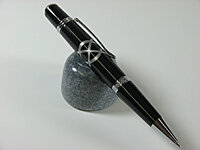I agree CA has always been questionable. When I use it I always use thick formula or epoxies.
Next problem, oily woods or wood that moves even after drilling.
Notorious for cracking after drilling and gluing immediately are woods like Snakewood, Pink Ivory, Ebony among others.
It's not only the glue but it's the movement of the wood. I've found on those mentioned above, I will always drill them carefully and let them sit for a week.
Slide the drill in, doesn't? Then redrill, sit another week. Check it again. When the drill slides in the wood has stabilized. Now you're ready to glue. Sand the tubes and wipe them clean.
Remember for oily woods to clean the blanks hole using a q-tip with something like DNA just before you glue tube in. I always clean any blank this way.
Another trick I've learned from Bill at the original Arizona Silhouette is to plug the ends of the Tubes. I use dental wax, available from them.
Just push the end of the tube perpendicular into the wax sheet. Wipe the outside end of the tubes to remove excess wax.
I learned a long time ago plastics, acrylics and the like are stable and don't move. But you always have to get the glue in the blank.
This is how I glue. Now that the Tubes are plugged, you place your glue over complete tube, press it into one end of blank.
Quickly remove tube, add glue again, place the opposite end of tube into other end of blank, rotating it as you push it in.
One problem here. Oily wood, tight holes and other issues may not allow you to remove and replace the tube. DAMHIKT. Work fast!
Now let the glue set up at least a day or more based on the glue used.
Next punch out the wax, scrape any glue that may have rolled over the tubes end with a sharp knife or a fine round file, then use a q-tip to remove wax and filings from each end inside of tube. Trim the ends of tubes and your ready to turn.


